
Sri Lanka, historically known as Ceylon and officially the Democratic Socialist Republic of Sri Lanka, is an island country in South Asia. It lies in the Indian Ocean, southwest of the Bay of Bengal, separated from the Indian peninsula by the Gulf of Mannar and the Palk Strait. Sri Lanka shares a maritime border with the Maldives in the south-west and India in the north-west.

Poḷonnaruwa, also referred as Pulathisipura and Vijayarajapura in ancient times, is the main town of Polonnaruwa District in North Central Province, Sri Lanka. The modern town of Polonnaruwa is also known as New Town, and the other part of Polonnaruwa remains as the royal ancient city of the Kingdom of Polonnaruwa.
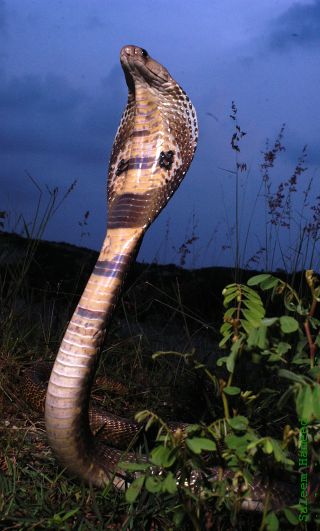
The Indian cobra, also known commonly as the spectacled cobra, Asian cobra, or binocellate cobra, is a species of cobra, a venomous snake in the family Elapidae. The species is native to the Indian subcontinent, and is a member of the "big four" species that are responsible for the most snakebite cases in India.
The Sri Lankan Kaffirs are an ethnic group in Sri Lanka who are partially descended from 16th-century Portuguese traders and Bantu slaves who were brought by them to work as labourers and soldiers to fight against the Sinhala kings. They are very similar to the Zanj-descended populations in Iraq and Kuwait, and are known in Pakistan as Sheedis and in India as Siddis. The Kaffirs spoke a distinctive creole based on Portuguese, and the "Sri Lankan Kaffir language". Their cultural heritage includes the dance styles Kaffringna and Manja and their popular form of dance music Baila.

Najas, the water-nymphs or naiads, is a genus of aquatic plants. It is cosmopolitan in distribution, first described for modern science by Linnaeus in 1753. Until 1997, it was rarely placed in the Hydrocharitaceae, and was often taken as constituting the family Najadaceae.
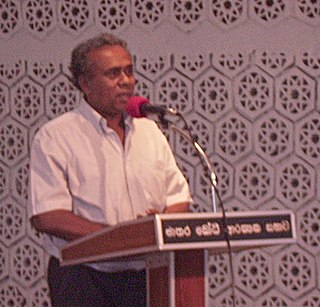
Thakurartha Devadithya Guardiyawasam Lindamulage Nalin Kumara de Silva is a Sri Lankan philosopher and a political analyst. He is the former Sri Lankan ambassador in Myanmar. He was a professor in the department of mathematics, a member of University Grant Commission and the dean of the faculty of science at the University of Kelaniya, Sri Lanka.
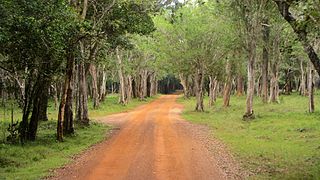
Wilpattu National Park is a national park in Sri Lanka. The unique feature of this park is the existence of "Willus" – natural, sand-rimmed water basins or depressions that fill with rainwater. Located on the northwest coast lowland dry zone of Sri Lanka, the park is 30 km (19 mi) west of Anuradhapura and 26 km (16 mi) north of Puttalam. The park is 1,317 km2 (508 sq mi) in area and ranges from 0–152 m (0–499 ft) above sea level. Nearly one hundred and six lakes (Willu) and tanks are found spread throughout Wilpattu. Wilpattu is the largest and one of the oldest national parks in Sri Lanka. Wilpattu is world-renowned for its leopard population. A remote camera survey conducted in Wilpattu from July to October 2015 by the Wilderness and Wildlife Conservation Trust captured photographs of forty-nine individual leopards in the surveyed area, the core area density of which was between that of Yala National Park's Block I and Horton Plains National Park.

The irrigation works in ancient Sri Lanka, the earliest dating from about 300 BCE, in the reign of King Pandukabhaya and under continuous development for the next thousand years, were some of the most complex irrigation systems of the ancient world. In addition to constructing underground canals, the Sinhalese were the first to build completely artificial reservoirs to store water. The system was extensively restored and further extended during the reign of King Parākramabāhu.

Udawattakele Forest Reserve often spelled as Udawatta Kele, is a historic forest reserve on a hill-ridge in the city of Kandy. It is 104 hectares large. During the days of the Kandyan kingdom, Udawattakele was known as "Uda Wasala Watta" in Sinhalese meaning "the garden above the royal palace". The sanctuary is famous for its extensive avifauna. The reserve also contains a great variety of plant species, especially lianas, shrubs and small trees. There are several giant lianas. Many of small and medium size mammals that inhabit Sri Lanka can be seen here. Several kinds of snakes and other reptiles might be seen. Udawattakele was designated as a forest reserve in 1856, and it became a sanctuary in 1938.

Najas marina is a species of aquatic plant known by the common names spiny water nymph, spiny naiad and holly-leaved naiad. It is an extremely widespread species, reported across Europe, Asia, Africa, Australia, the Americas and many oceanic islands. It can be found in many types of freshwater and brackish aquatic habitat, including bodies of alkaline water.
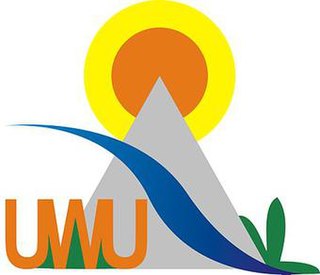
Uva Wellassa University is a Sri Lankan national university. The university was established by government gazette effective 1 June 2005 in Badulla, Sri Lanka as the 14th national university of Sri Lanka. President Chandrika Kumaratunga established the university in 2007. The university was officially opened by Sri Lankan president Mahinda Rajapaksa on 5 August 2009. It is the first all-entrepreneurial university in Sri Lanka. It is designed to provide essential skills and broad general education for all students while providing the conceptual and methodological background and the training to obtain practical solutions for value addition to the national resources base of Sri Lanka.

Maduru Oya National Park is a national park of Sri Lanka, established under the Mahaweli development project and also acts as a catchment of the Maduru Oya Reservoir. The park was designated on 9 November 1983. Providing a sanctuary to wildlife, especially for elephants and protecting the immediate catchments of five reservoirs are the importance of the park. A community of Vedda people, the indigenous ethnic group of Sri Lanka lives within the park boundary in Henanigala. The park is situated 288 kilometres (179 mi) north-east of Colombo.
Najas pseudogracillima, called the Hong Kong water nymph, is an aquatic plant growing in fresh water ponds. It is a rare and little-known species known from one collection from a pond on the campus of Chung Chi College at the Chinese University of Hong Kong. It is very similar to N. gracillima except that the male inflorescences lack a spathe.
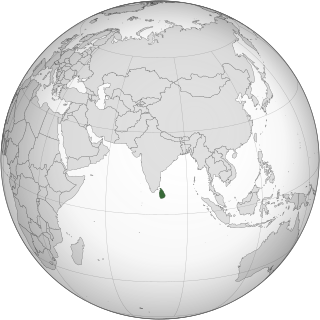
Environmental issues in Sri Lanka include large-scale logging of forests and degradation of mangroves, coral reefs and soil. Air pollution and water pollution are challenges for Sri Lanka since both cause negative health impacts. Overfishing and insufficient waste management, especially in rural areas, leads to environmental pollution. Sri Lanka is also vulnerable to climate change impacts such as extreme weather events and sea level rise.

Rekawa Lagoon is a coastal waterbody located in Hambantota Districtt in the Southern Province, Sri Lanka and it is located 200 km (120 mi) south of Colombo. The lagoon possesses a rich biodiversity with a variety of flora and fauna.

Channa Jayasumana is a Sri Lankan medical academic, politician, Cabinet Minister, and member of the Parliament of Sri Lanka for the Anuradhapura District.

The tank cascade system, or wewa-ellangava system, is an ancient Sri Lankan irrigation infrastructure. The system is a network of small tanks draining to large reservoirs that store rainwater and surface runoff for later use. Originating in the 1st millennium BCE, the system was designated as a Globally Important Agricultural Heritage System by the United Nations Food and Agriculture Organization in 2017. Centralized bureaucratic management of large-scale systems was implemented from the 3rd to the 13th centuries.














